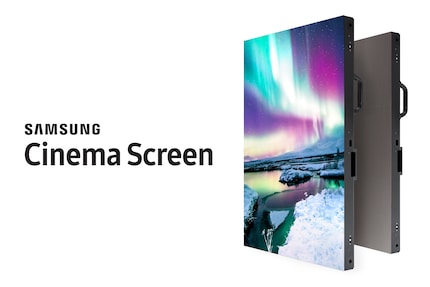
Background information
Onyx Cinema LED: Making of a cinema revolution
by Luca Fontana

MicroLED is the future of screen tech. There's no other conclusion to draw from the fact that manufacturers such as Samsung and even OLED pioneer LG are investing millions in this new technology. Yet, I'm not fully convinced. Here's my prognosis.
OLED, the screen technology with self-illuminating pixels, seems to be the dominant topic in the TV industry. Why? It currently offers the best image quality. LG's subsidiary LG Display has a monopoly on OLEDs and supplies its panels to all manufacturers of OLED televisions.
However, at the beginning of the year, Samsung made its OLED competitors sit up and take notice. At CES 2018, they presented «The Wall», a 146-inch MicroLED television. Their declared goal? Overthrowing OLED. Half a year later, at IFA 2018, LG presented their answer: a 175-inch MicroLED TV.
Bigger is better, right?
This seems to be more than just a side blow to the competitor, but possibly even an admission that OLED – previously advertised as unbeatable – might not be the ultimate screen tech after all.
The question arises: Is MicroLED the end of OLED?
MicroLED is basically the same as OLED but without the organic material. When it comes to OLED technology, the word «organic» is slightly confusing, as it's often used as a synonym to «biological» or «natural». In chemistry, however, the English term «organic» means carbon-based. OLED uses compounds that are based on carbon molecules. MicroLED, on the other hand, relies on gallium nitride, a synthetic material.
MicroLEDs can be built much smaller than conventional LEDs. Apart from this, they work almost identically. What does this mean? Three red, green and blue subpixels form one single pixel. The colour of the pixel depends on how bright each subpixel shines. However, there is no backlighting – a MicroLED pixel is both a subpixel and a light source, just like an OLED pixel.
MicroLED is supposed to offer all the advantages of OLED technology – above all, the perfect black levels – without its disadvantages. What the disadvantages of OLED are? These two aspects in particular:
These are problems that MicroLED technology doesn't have. In addition, synthetic LEDs are much brighter than OLEDs: While OLED TVs reach about 1,000 nits – nits are the measure of light emitted per unit area – today's synthetic LEDs already offer 2,000 nits. This is particularly useful if you're watching TV in light-flooded rooms. A potential downside of this brightness is the fact that colours fade when they shine too brightly – an issue that's all too familiar when it comes to projectors. LCD proponents say: It's all a question of configuration.
It's uncertain how long it will take until our home cinema devices are equipped with MicroLED. Samsung is speaking of a time span between one and nine years – an estimate that doesn't help anyone. If I had to make a more precise prognosis, I'd say it will probably be closer to nine years than to one. This technology is still in such early stages of development that it's unlikely to make a short-term impact when it comes to home cinema.
The reason behind this is the modular design of MicroLED panels: It's not yet possible to place all MicroLEDs on a single back panel. Instead, the panel consists of several individual modules. Reports from CES 2018 often mentioned irritating and visible connections between the individual modules, especially when moving objects jumped from one module to another.

However, the modular architecture is ideal for large LED screens, making them easier to service. If a MicroLED breaks, only its module has to be replaced, not the entire screen. On top of this, the connections are hardly visible from a large distance.
Sports stadiums, public viewings, shopping malls or even cinemas are suitable locations for large MicroLED screen. Samsung already offers «Onyx Cinema LED» – in Switzerland, this technology can only be enjoyed on Screen 5 of the Arena Cinema in the Sihlcity shopping centre. Video producer Manuel Wenk and I went there last summer and took a look behind the scenes (article in German).
What struck us most was the outstanding colour rendering. This isn't much of a surprise, as Samsung's MicroLED screens strive for a coverage of 120 percent of the DCI-P3 colour space. What this means? Let's take a closer look.
Colour spaces describe the range of colours that's covered – from all colours that are visible to the human eye. Different sources – Blu-ray or Ultra HD Blu-ray, for instance – cover different sizes of colour spaces. The DCI-P3 standard covers about 45 percent of the spectrum that's visible to us; HDR content covers about 90 percent of the DCI-P3 standard. According to manufacturers, OLEDs are able to cover almost 100 percent of the DCI-P3 standard if the content allows. With a DCI-P3 coverage of 120 percent, MicroLEDs would clearly outperform this.
A few years may pass before there is content with such a high colour space coverage. So it's probably not a bad thing that MicroLED technology is on its way.
Samsung isn't the only company that's thinking about the medium-term future. At IFA 2018, an LG spokesperson confirmed that the company has initiated research and development projects for MicroLED technology. An official announcement from LG has yet to be issued.
This is quite a balancing act for LG: On the one hand, it makes sense for the Korean company to secure shares in this new and promising market segment. It's important not to be outpaced, even though Samsung seems to be more advanced in its research. On the other hand, LG runs the risk of weakening its OLED business by focusing on MicroLED. The key question is: Which screen technology is better and more sustainable for the future?
Manufacturers outside of South Korea – Sony or Apple, for instance – have also invested millions in developing of this technology.

Apparently, Apple is trying to incorporate the technology into its Apple Watch. It wouldn't be the first time the Californian powerhouse is testing a new display technology with its smartwatch: In 2014, Apple's first product with an AMOLED display was a smartwatch. The technology was only integrated into the iPhone X three years later. This is Apple's attempt to be more independent, as they currently rely on Samsung for AMOLED displays. Similar motifs are likely to be the driving force for Sony, who are supplied with OLED displays by LG. LG presented a modular MicroLED panel as far back as 2016, followed by a 120-inch model at the ISE 2018. Its price tag? 500,000 francs.
There seems to be a rather clear common goal: Getting MicroLED ready for the market within the next decade.
«The Wall», which was presented by Samsung in January 2018, is a glimpse into the future. It's a statement. It's Samsung's way of saying: We can build it and it looks good. Ironically, the challenge isn't producing MicroLED screens that are as large as possible – as the introduction to this article may have suggested – but rather making them as small as possible. Why? The modular architecture is more suitable for large screens.
Pixel density is decisive when it comes to determining how difficult it is to produce a screen: the smaller the screen size, the less space there is for the pixels. Keep in mind, every pixel is made up of three subpixels. Each subpixel has to be produced and calibrated individually. Apple experienced this to be such a complex challenge that the project was almost discontinued a year ago. It wasn't until the end of 2017 that the Californians achieved a breakthrough.
It remains to be seen whether MicroLEDs will ever become relevant for the home cinema market. The development for this segment will take years – years in which OLED pioneer LG will also continue to develop and improve organic light-emitting diodes. In addition, the production of synthetic MicroLEDs seems to be much more complex than that of OLEDs. Without a doubt, this fact will have an impact on the price.
What we know so far is that MicroLED is predestined for large screens. However, as long as MicroLED panels can't be manufactured without splitting – or at least without visible connections – this new technology won't manage to establish itself in the home cinema market. That's my opinion.
In my mind, MicroLED is an extremely interesting and relevant technology – but not for home cinema use. This might be a (potentially too) risky prognosis. I'd love to look back at this article in five to ten years and see if I was right or not.
Let’s get back to our question: Is MicroLED the end of OLED? I doubt it.
And now I’d like to know what you think!
Will OLED be replaced by MicroLED in the future?
The competition has ended.
I write about technology as if it were cinema, and about films as if they were real life. Between bits and blockbusters, I’m after stories that move people, not just generate clicks. And yes – sometimes I listen to film scores louder than I probably should.
Interesting facts about products, behind-the-scenes looks at manufacturers and deep-dives on interesting people.
Show all